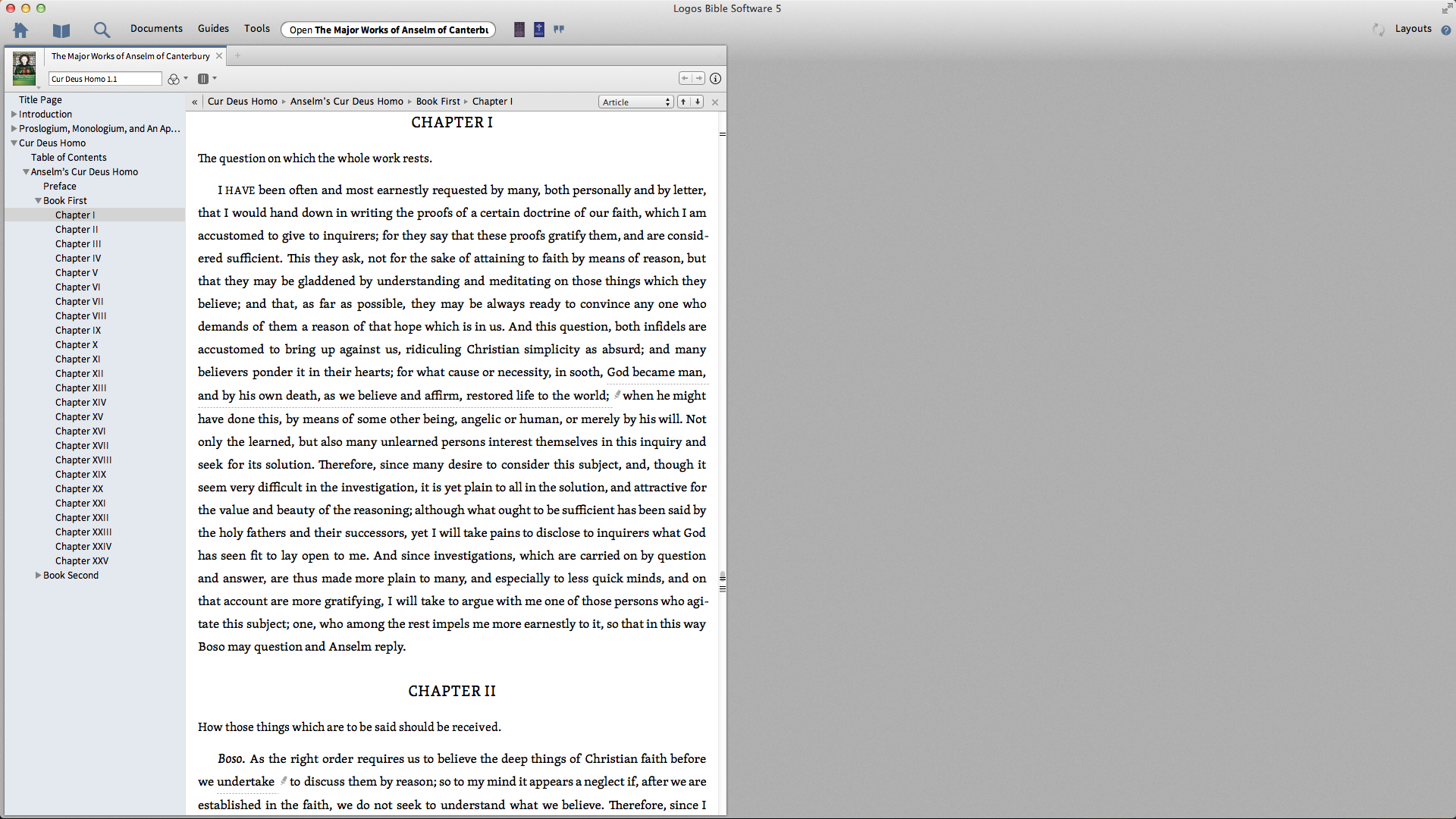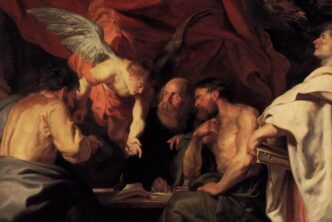The Cited By tool is arguably the most powerful tool in Verbum—it shows you how and where all of your texts are interconnected, making research on a scholarly or lay-level something much easier (and even a lot more fun). My goal today is to demonstrate the power of the Cited By tool, and hopefully discover some insightful and enlightening truths along the way.
Today’s journey begins with a book I own outside of Verbum: Charles Taylor’s A Secular Age, a book written in an attempt to trace the history of the development of secularism. It’s a fascinating read, but what struck me today was a passage he wrote concerning St. Anselm:
…There is one enigma which Christians… have to recognize, and that is the puzzle of evil; why in spite of knowing that we are born for the highest, we sometimes not only inexplicably choose against it, but even feel that we cannot do otherwise. The symmetrical mystery is that God can act to overcome this incapacity—the doctrine of grace. Anselm expressed this double mystery in terms of crime and punishment. The incapacity is explained as our just desert for our original falling away… Not only is our punishment now permissible, but some has to be exacted as a reparation for our fault, according to the juridical logic of this conception…. But in order to do this he has to have the reparation paid by his son, and then count it as satisfaction for our sins, in an act of gratuitous mercy. Needless to say, this wasn’t the only way that [this] double mystery could be articulated. Eastern fathers, like Gregory of Nyssa, put things differently. But Augustine and Anselm shaped the theology of Latin Christendom in this regard, and the Reformation, far from correcting this imbalance, aggravated it.[1]
Taylor thinks that Anslem’s (pre-dated by Augustine’s) conception of how we are saved led to the Protestant Reformers taking up an even stricter (and more imbalanced) soteriological viewpoint. But my question is: were Anselm’s and Gregory’s idea about salvation really imbalanced to begin with? Also, how did the Eastern Fathers understand this “double mystery” of punishment and grace as opposed to the Latin Fathers?
The logical place to begin is in Anselm’s Cur Deus Homo, or “Why God Became Man.” This is a book written as a dialogue between student (Boso) and teacher (Anselm) in an attempt to answer the questions about the method God chose to save mankind. So, let’s open it up along with the Cited By tool. [Click the images to zoom]

Clicking on Anslem’s Cur Deus Homo we immediately see 37 references to this work in the Cited By tool. This is great news because it means that I have many different options when considering a place to start researching. If I open up the Cited By tool in a larger window by clicking “more” at the bottom of the pane, I can scroll through to see all of the references made to Cur Deus Homo in my entire library.
Scrolling down a bit, I see a chapter on the nature of Christ’s suffering I’d like to read in Breviloquium, Bonaventure’s comprehensive work on Christian doctrine. Opening this up to chapter 9, I find a couple of key sentences giving me clues regarding Anselm’s understanding of redemption. Bonaventure’s first reference of Cur Deus Homo is found in section three where he states:
“…the work of restoration must respect the honor of God. Christ, therefore, brought it about by offering to the Father a fully satisfactory obedience. Satisfaction means the repayment of the honor due to God.”
Bonaventure goes on to state that Christ’s divine nature and innocence heals the rift made by mankind’s evil nature. He understands the restoration of man as a kind of “harmonious exchange” by which “evils should be healed through their opposites.” So there’s good evidence here that Taylor is right in thinking Anselm, along with other Latin Fathers, understand man’s redemption—at least in part—as a kind of “penal restitution.”
Going back to the Cited By list, I see a document called: “Soteriology: A Dogmatic Treatise on the Redemption” by Msgr. Joseph Pohle, Ph.D., D.D. This looks promising, as the question at hand is precisely about how the Church Fathers understand salvation.
Clicking on the reference I read that Anselm is cited here relating that God could have chosen not to save mankind (that is, he wasn’t required to redeem the human race) but chose to do so out of infinite mercy. Reading a bit further, I see that Pohle outlines Anselm and Augustine’s soteriological perspective a bit more precisely:
“Sin involves a sort of infinite guilt and cannot be adequately atoned for except by an infinite satisfaction. (Cfr. St. Thomas, S. Theol., 3a, qu. 2, ad 2.) The Fathers held that not even the human nature of Christ… considered apart from the Hypostatic Union, could make adequate satisfaction for our sins… For, in the words of St. Augustine, “we could not be redeemed, even by the one Mediator between God and men, then man Christ Jesus, if He were not also God.” (St. Augustine, Enchir., c. 108)
I feel at this point I’ve collected enough information about Anselm and Augustine to affirm that they indeed saw redemption as a kind of “trade off,” albeit in a kind of infinite magnitude. But is this really so different from the Gregory of Nyssa’s position, as Taylor states? Let’s take a look at what Saint Gregory of Nyssa had to say and see if there really is an “imbalance” in the soteriological approaches of the early Church Fathers.
I’ll start by typing in “Gregory of Nyssa” in the search bar. If I click enter, I am instantly taken to the Nicene and Post-Nicene Fathers volume on Gregory of Nyssa.
Since this volume is so large, it might be best to begin with a search in just this text. Let’s try a term that pertains to the kind of judicial language that Anselm and Augustine have been using. I’ll type in “ransom”:
The first result that comes up looks promising, and clicking it I find Gregory speaking of a master who wishes to release one slave in return for another. He writes,
“For as they who have bartered away their freedom for money are the slaves of those who have purchased them [Gregory is talking about mankind here]… it was requisite that no arbitrary method of recovery, but the one consonant with justice should be devised by [God]… to make over to the master of the slave whatever ransom he may agree to accept for the person in his possession.”
Gregory’s views here are pretty remarkable. He essentially posits that God gives his son as a kind of ransom to Satan—the master of sinners—in exchange for the freedom of mankind. Of course, Satan cannot “take” Christ in any meaningful way, and so he is beaten at his own game. Mankind is freed, but Satan remains in bondage. Gregory concludes,
“[God’s] choosing to save man is a testimony of his goodness; His making the redemption of the captive a matter of exchange exhibits His justice, while the invention whereby He enabled the Enemy to apprehend that of which he was before incapable, a manifestation of supreme wisdom.”
We learn a few things here. First, that Gregory has a very different view of the satisfactory justice required in the transaction of man’s redemption than a majority of the Church Fathers. But two, we learn that Gregory does indeed think of mankind’s redemption in “legal” or “penal” terms, but he understands it differently than do other Church fathers. From what we’ve seen so far, we may conclude that Taylor poses a false dichotomy between the primary soteriological differences between Eastern and Western Fathers.
If we glance over at the Cited By tool while reading this section by Gregory of Nyssa, we find a reference to A Catholic Dictionary citing this very passage in Gregory’s work. Clicking it, we can read the larger historical context surrounding Gregory’s thinking and the debate circling the questions of how mankind is redeemed through Church history.
So what have we learned?
First, that Anselm does indeed think very differently than Gregory on the issue of redemption, but not in the way that we first expected. We’ve certainly gathered that more research into this topic will be necessary to better flesh out the differences and similarities between Gregory of Nyssa and other Church Fathers. But we’ve also learned that with just a few simple clicks the Cited By tool is an extremely powerful tool allowing us to dig into topics and books that we may not have even been aware of in the first place. With a library full of Church documents, primary and secondary sources that are all linked together, research is made much easier and engaging.
[1] Charles Taylor, A Secular Age, p. 78.











I’m having trouble getting the cited by tool to follow my resources. I have the linking set to “Follow” but it still won’t cite anything but Bible verses. What am I dong wrong?
Thanks!
Hm, not sure. What version of the software are you running?
Aric,
This was a great post illustrating the power of the software. Thanks for posting. I often do things like this and it amazes me how much you can see in such a short time in just a few movements with little expertise in the software.
Excellent.